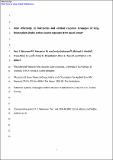Files in this item
How effectively do horizontal and vertical response strategies of long-finned pilot whales reduce sound exposure from naval sonar?
Item metadata
| dc.contributor.author | Wensveen, Paulus Jacobus | |
| dc.contributor.author | von Benda-Beckmann, Alexander M | |
| dc.contributor.author | Ainslie, Michael A | |
| dc.contributor.author | Lam, Frans-Peter A | |
| dc.contributor.author | Kvadsheim, Petter H | |
| dc.contributor.author | Tyack, Peter L | |
| dc.contributor.author | Miller, Patrick J O | |
| dc.date.accessioned | 2016-02-24T00:12:03Z | |
| dc.date.available | 2016-02-24T00:12:03Z | |
| dc.date.issued | 2015-05 | |
| dc.identifier | 191321558 | |
| dc.identifier | d8360985-08cd-4330-880e-38280705c0eb | |
| dc.identifier | 25795075 | |
| dc.identifier | 84932639504 | |
| dc.identifier | 000353080900008 | |
| dc.identifier.citation | Wensveen , P J , von Benda-Beckmann , A M , Ainslie , M A , Lam , F-P A , Kvadsheim , P H , Tyack , P L & Miller , P J O 2015 , ' How effectively do horizontal and vertical response strategies of long-finned pilot whales reduce sound exposure from naval sonar? ' , Marine Environmental Research , vol. 106 , pp. 68-81 . https://doi.org/10.1016/j.marenvres.2015.02.005 | en |
| dc.identifier.issn | 0141-1136 | |
| dc.identifier.other | ORCID: /0000-0002-8409-4790/work/60887833 | |
| dc.identifier.uri | https://hdl.handle.net/10023/8288 | |
| dc.description | PJW was supported with studentships of The Netherlands Ministry of Defence (grant number 032.30370/01.02) and the VSB Foundation (grant number VSB.08/228-E) and Ren e Dekeling is acknowledged for making funding possible. The 3S project was supported by the US Office of Naval Research, The Netherlands Ministry of Defence, Royal Norwegian Navy and Norwegian Ministry of Defence, and by World Wildlife Fund Norway. PLT received funding from the MASTS pooling initiative (The Marine Alliance for Science and Technology for Scotland) and their support is gratefully acknowledged. | en |
| dc.description.abstract | The behaviour of a marine mammal near a noise source can modulate the sound exposure it receives. We demonstrate that two long-finned pilot whales both surfaced in synchrony with consecutive arrivals of multiple sonar pulses. We then assess the effect of surfacing and other behavioural response strategies on the received cumulative sound exposure levels and maximum sound pressure levels (SPLs) by modelling realistic spatiotemporal interactions of a pilot whale with an approaching source. Under the propagation conditions of our model, some response strategies observed in the wild were effective in reducing received levels (e.g. movement perpendicular to the source's line of approach), but others were not (e.g. switching from deep to shallow diving; synchronous surfacing after maximum SPLs). Our study exemplifies how simulations of source-whale interactions guided by detailed observational data can improve our understanding about motivations behind behaviour responses observed in the wild (e.g., reducing sound exposure, prey movement). | |
| dc.format.extent | 14 | |
| dc.format.extent | 1480660 | |
| dc.language.iso | eng | |
| dc.relation.ispartof | Marine Environmental Research | en |
| dc.subject | Cetaceans | en |
| dc.subject | Disturbance | en |
| dc.subject | Behaviour | en |
| dc.subject | Environmental impact | en |
| dc.subject | Noise | en |
| dc.subject | Risk assessment | en |
| dc.subject | Individual-based models | en |
| dc.subject | Sonar | en |
| dc.subject | QH301 Biology | en |
| dc.subject | SDG 14 - Life Below Water | en |
| dc.subject.lcc | QH301 | en |
| dc.title | How effectively do horizontal and vertical response strategies of long-finned pilot whales reduce sound exposure from naval sonar? | en |
| dc.type | Journal article | en |
| dc.contributor.sponsor | Office of Naval Research | en |
| dc.contributor.sponsor | Office of Naval Research | en |
| dc.contributor.institution | University of St Andrews. School of Biology | en |
| dc.contributor.institution | University of St Andrews. Centre for Social Learning & Cognitive Evolution | en |
| dc.contributor.institution | University of St Andrews. Marine Alliance for Science & Technology Scotland | en |
| dc.contributor.institution | University of St Andrews. Sea Mammal Research Unit | en |
| dc.contributor.institution | University of St Andrews. Sound Tags Group | en |
| dc.contributor.institution | University of St Andrews. Bioacoustics group | en |
| dc.contributor.institution | University of St Andrews. Scottish Oceans Institute | en |
| dc.contributor.institution | University of St Andrews. Institute of Behavioural and Neural Sciences | en |
| dc.identifier.doi | https://doi.org/10.1016/j.marenvres.2015.02.005 | |
| dc.description.status | Peer reviewed | en |
| dc.date.embargoedUntil | 2016-02-24 | |
| dc.identifier.grantnumber | en | |
| dc.identifier.grantnumber | N00014 08 1 0984 | en |
This item appears in the following Collection(s)
Items in the St Andrews Research Repository are protected by copyright, with all rights reserved, unless otherwise indicated.

